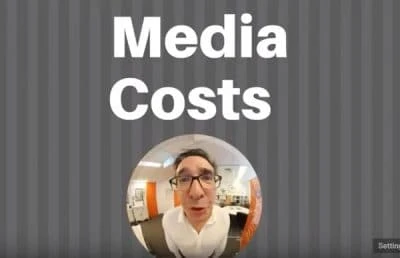This is the next in a series of one-minute videos that address one of the many complex challenges facing marketing, media and advertising today. The Golden Minute series attempts to prove Albert Einstein right when he said, “The definition of genius is taking the complex and making it simple”.
But he also said, “Everything should be made as simple as possible, but not simpler”. So we will leave it for you to judge. Please let us know here if there is a topic you would like us to cover in a Golden Minute.
Mega successful investor Warren Buffet famously said, “Price is what you pay; value is what you get”. But when it comes to media, the discussion is almost always about price – price and quantity such as GRP, CMP, Impressions, spots and the like.
These are all measures of the quantity of media and audience delivery, but rarely is there a measure of quality. After all, media quality is a much more difficult attribute to measure or validate.
But the lack of quality measures or at least the difficulty in creating one should not be the reason not to try. The lack of this quality measure is what contributes to the perception that media is simply a commodity that is to be negotiated and bought by the ton.
It was only recently that a long term marketing procurement specialist tried to correct me on this, saying that media is the oldest commodity in advertising. But there are some major implications if you accept that media is simply a commodity to be purchased as a volume at a price.
The first issue we are already witnessing is the treatment of media as a commodity, as evidenced by a procurement approach for media based on value and price. I remember the first time I was witness to a procurement process of a reverse auction on media buying with the buyer asking agencies to bid on supplying media with a committed cost per thousand (CPM), with the lowest CPM bid the winner.
Even as recently as the past month, we have seen media agency contracts awarded based on a commitment to the lowest cost per volume without consideration for the performance and relevance of that media being purchased.
But without the measure of the quality of the media inventory, it is difficult to justify a higher cost per unit. We understand this and have worked with many advertisers to provide a measure of quality, and the most compelling measure of media quality is performance.
Ultimately, investing in any media channel is to deliver a desired outcome. By working through the marketing, channel, and media strategy, we focus on defining the desired outcomes, and the media attributes that contribute to these measurable outcomes. Only by building a business case for the media investment have we been able to substantiate a media buying strategy that is no longer based on the lowest cost alone.
One of the key issues is the ability of a media channel to deliver not only a real person but a person identified as a customer or potential customer and deliver in a manner, place, format and time to be received and to encourage a response from that customer.
Of course, this means that the channels and metrics will be specific to the strategy. This is often an issue as many advertisers want to embrace an industry standard. Still, the complexity and fragmentation within the media landscape means diverse strategies and multiple outcomes.
And there’s another fundamental flaw with a ‘cost in’ approach to media, especially when you’re using it as a primary metric to select an agency based on advance promises of rate delivery (and hold them to those promises). It can’t completely factor in the myriad variables that can apply to a media buy at any given time. This issue has always existed but is exacerbated a thousand-fold by increased complexities in the market, in buying methodologies, in consumer paths to purchase, to name just a few.
So what happens when an agency makes promises on rate or cost efficiency, and then things change? Well – it strives to buy the cheapest media within a channel, to hit cost KPIs. It tries to build media plans for a campaign based on channels and suppliers in which it knows it will be more likely to achieve the numbers. It buys increasing amounts of inventory in bulk (cheaper) and on-sells that inventory to the client (making a hidden margin, but still cheaper overall, thus hitting numbers).
It fudges results – doesn’t lie, or at least the majority don’t lie. Still, it manipulates numbers, the context of the buy, the trading conditions, and the type of inventory demands the client makes on a particular campaign. Essentially, it will look for loopholes that enable targets to be met, media auditors to be satisfied, and bonuses to be paid.
In short, a cost-in approach drives the agency down a ‘cheapest is essential’ route for at least some of the buy. It makes the agency subjective, not objective, in delivering solutions. Agencies will never admit any of this. But how else can they keep these kinds of clients and hit their targets without at least a proportion of their thinking being driven in this way? And, more importantly, how much does this approach do for the commercial results of the campaign? Not much good, that’s for sure.
Aligning media strategy to the business and marketing objectives means the delivery of the outcomes. This focuses on delivering those outcomes rather than simply the cost of the media alone. It is a performance-based investment model and replaces the cost reduction commodity strategy currently in place. It keeps your agency both objective and honest. And it allows focusing on quality, strategy, and attribution, not just trading and media metrics.
Golden Minute Script
Media is a pretty big investment you don’t want to overpay.
That’s why advertisers want their media agency to guarantee lower cost per thousands.
But buying on cost suggests that media is a commodity.
When in fact media is anything but a commodity.
There is high quality inventory.
Then there is the media you buy at the lowest possible cost.
Imagine you buy media at $20 per impression.
And they guarantee a real person will see it.
Or you can buy media at just $2 an impression?
Yet half those ads will not seen by a real person while the other half may end up on a porn site or… So which one is the best value?
$20 an impression or $2 of worry?
Lets just say one is definitely a good price while the other is at least ten times the value.
Are you concerned about the value you are obtaining from your media investment? Find out about our comprehensive media assessment service here




